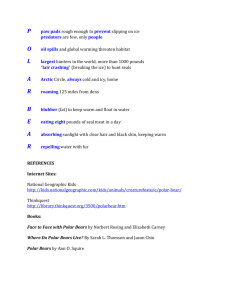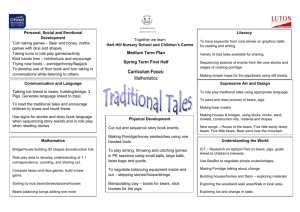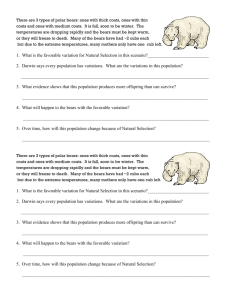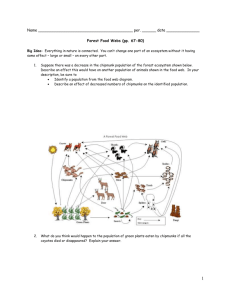Teddy Graham Lab
advertisement
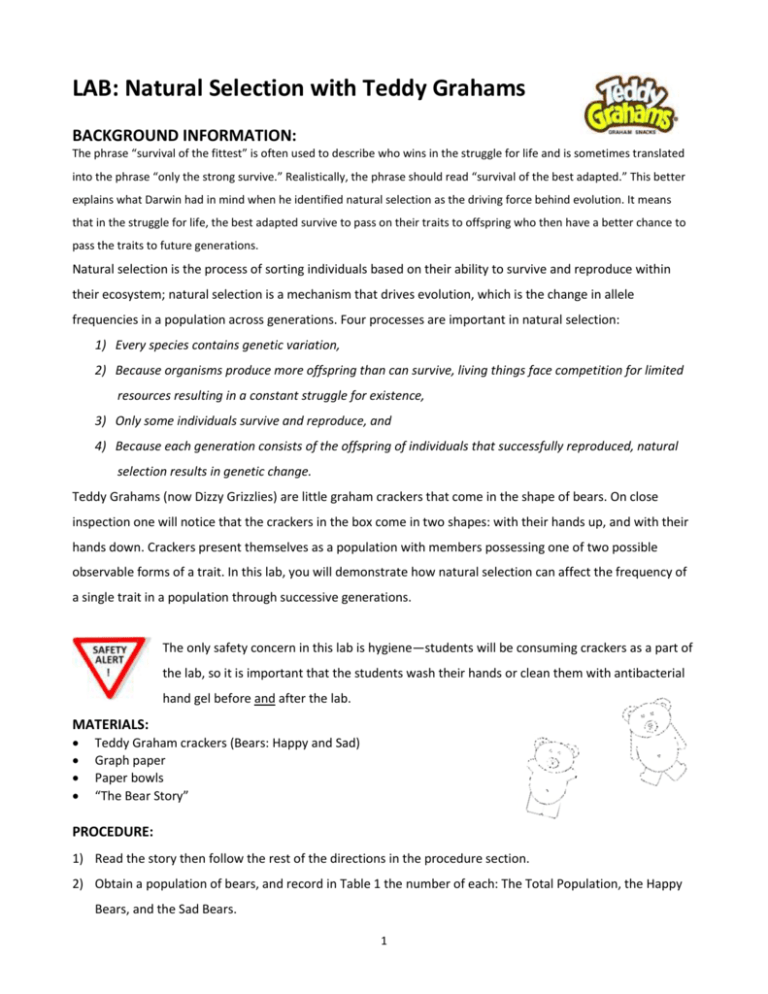
LAB: Natural Selection with Teddy Grahams BACKGROUND INFORMATION: The phrase “survival of the fittest” is often used to describe who wins in the struggle for life and is sometimes translated into the phrase “only the strong survive.” Realistically, the phrase should read “survival of the best adapted.” This better explains what Darwin had in mind when he identified natural selection as the driving force behind evolution. It means that in the struggle for life, the best adapted survive to pass on their traits to offspring who then have a better chance to pass the traits to future generations. Natural selection is the process of sorting individuals based on their ability to survive and reproduce within their ecosystem; natural selection is a mechanism that drives evolution, which is the change in allele frequencies in a population across generations. Four processes are important in natural selection: 1) Every species contains genetic variation, 2) Because organisms produce more offspring than can survive, living things face competition for limited resources resulting in a constant struggle for existence, 3) Only some individuals survive and reproduce, and 4) Because each generation consists of the offspring of individuals that successfully reproduced, natural selection results in genetic change. Teddy Grahams (now Dizzy Grizzlies) are little graham crackers that come in the shape of bears. On close inspection one will notice that the crackers in the box come in two shapes: with their hands up, and with their hands down. Crackers present themselves as a population with members possessing one of two possible observable forms of a trait. In this lab, you will demonstrate how natural selection can affect the frequency of a single trait in a population through successive generations. The only safety concern in this lab is hygiene—students will be consuming crackers as a part of the lab, so it is important that the students wash their hands or clean them with antibacterial hand gel before and after the lab. MATERIALS: Teddy Graham crackers (Bears: Happy and Sad) Graph paper Paper bowls “The Bear Story” PROCEDURE: 1) Read the story then follow the rest of the directions in the procedure section. 2) Obtain a population of bears, and record in Table 1 the number of each: The Total Population, the Happy Bears, and the Sad Bears. 1 3) Eat three Happy Bears. If you don't have three Happy Bears, then eat what you have in Happy Bears. 4) Get a new generation from the teacher. Repeat steps one and two. 5) Repeat for two more generations (total of four). 6) Determine the percentage of sad and happy bears for each generation (divide the number of that type of bear by the total number in that generation), record the percentages in Table 2, and graph the population results. HYPOTHESIS: What do you expect to happen to the number of Happy and Sad Bears over time? __________________________________________________________________________________________ RESULTS: Number of bears at the start? ______. This is generation one. Table 1: The number of bears for each generation Generation Number of Happy Bears Number of Sad Bears Total Bears 1 2 3 4 Table 2: The percentage of bears for each generation Generation Percentage of Happy Bears Percentage of Sad Bears 1 2 3 4 ANALYSIS 1) Graph what happens to the bear population over time. Graph the data from Table 2. Using the information form the data table above, plot your data on a graph below to show how your population changed over time. Use one color to represent the percent population of Happy bears, use another color to plot the percent population of Sad bears. 2 Title: ______________________________________________________________________________ Generation 1 Generation 2 Generation 3 Generation 4 Key: Percent of Happy Bears Percent of Sad Bears CONCLUSION: 1) How many new bears did you get for each generation? Generation 2 ____ Generation 3 ____ Generation 4 ____ 2) What happened to the percentage of each type of bear over time? a. Happy? _____________________________________________________________________________ b. Sad? _______________________________________________________________________________ 3) How does this compare with your hypothesis? __________________________________________________________________________________________ __________________________________________________________________________________________ 3 4) List the four conditions necessary for natural selection to occur. a. _____________________________________________________________________________________ b. _____________________________________________________________________________________ c. _____________________________________________________________________________________ d. _____________________________________________________________________________________ 5) Describe how this model met each of the four conditions. a. _____________________________________________________________________________________ b. _____________________________________________________________________________________ c. _____________________________________________________________________________________ d. _____________________________________________________________________________________ 6) Explain which trait is not favorable. __________________________________________________________________________________________ 7) Which phenotype is reduced in the population? ________________________________________________ 8) Explain what would happen if the selection pressure changed and the happy bear was selected for. __________________________________________________________________________________________ __________________________________________________________________________________________ __________________________________________________________________________________________ 9) Did natural selection occur? What is your evidence? __________________________________________________________________________________________ __________________________________________________________________________________________ __________________________________________________________________________________________ 10) Did the organisms adapt to their environment? Explain your answer. __________________________________________________________________________________________ __________________________________________________________________________________________ __________________________________________________________________________________________ 11) What was the force driving the natural selection? __________________________________________________________________________________________ __________________________________________________________________________________________ __________________________________________________________________________________________ 4 TEACHER’S GUIDE - LAB: Natural Selection with Teddy Grahams OBJECTIVES The student will be able to: 1. recognize that evolution is the change in allele frequencies in a population across generations; 2. understand how natural selection can result in a change in allele frequencies over time; 3. identify variation, survival, and reproduction as key elements of evolution by natural selection; 4. comprehend potential effects of predators on prey populations over time. SUMMARY/ABSTRACT Lab will help student/groups to answer the question of how natural selection can affect the frequency of a single trait in a population through successive generations. Data is gathered on the appearance of two phenotypes over successive generations as a specific selective force is applied. Students graph phenotype percentages to provide a visual representation of data collected during procedure. Story set-up and cracker "prey" place student in the center of activity as the selection pressure. Natural selection is the process of sorting individuals based on their ability to survive and reproduce within their ecosystem; natural selection is a mechanism that drives evolution, which is the change in allele frequencies in a population across generations. Four processes are important in natural selection: 1) Every species contains genetic variation, 2) Because organisms produce more offspring than can survive, living things face a constant struggle for existence, 3) Only some individuals survive and reproduce, and 4) Because each generation consists of the offspring of individuals that successfully reproduced, natural selection results in genetic change. In order to get students thinking about how natural selection occurs, discuss the classical examples of natural selection (peppered moths, giraffes) and the related misconceptions. TIME: 1 hour BACKGROUND INFORMATION: The phrase “survival of the fittest” is often used to describe who wins in the struggle for life and is sometimes translated into the phrase “only the strong survive.” Realistically, the phrase should read “survival of the best adapted.” This better explains what Darwin had in mind when he identified natural selection as the driving force behind evolution. It means that in the struggle for life, the best adapted survive to pass on their traits to offspring who then have a better chance to pass the traits to future generations. Teddy Grahams (now Dizzy Grizzlies) are little graham crackers that come in the shape of bears. On close inspection one will notice that the crackers in the box come in two shapes: with their hands up, and with their hands down. Crackers present themselves as a population with members possessing one of two possible observable forms of a trait. This makes them very convenient to use in a natural selection activity. Preparation for Natural Selection with Teddy Grahams requires either the purchase of Teddy Graham crackers, or photocopying and cut out of paper bears to simulate the crackers. Amount of crackers is dependant on 5 number of students in class, average about two - three boxes per class. Preparation of a lab involving food consumption should also be considered. Students need only a writing instrument and graph paper to complete lab. Class time needed is one hour class period with possible additional time for completion of graphs and questions. The only safety concern in this lab is hygiene—students will be consuming crackers as a part of the lab, so it is important that the students wash their hands or clean them with antibacterial hand gel prior to the start of the lab. ACTIVITY: MATERIALS: Teddy Graham crackers (Bears: Happy and Sad) Graph paper Paper bowls The Story of the Bears – make copies for student groups PROCEDURE: 1) Read the story and follow directions. 2) Obtain a population of bears, and record in Table 1 the number of each: The Total Population, the Happy Bears, and the Sad Bears. 3) Eat three Happy Bears. If you don't have three Happy Bears, then eat what you have in Happy Bears. 4) Get a new generation from the teacher. Repeat steps one and two. 5) Repeat for two more generations (total of four). 6) Determine the percentage of sad and happy bears for each generation (divide the number of that type of bear by the total number in that generation), record the percentages in Table 2, and graph the population results. STORY: The Bear Story You are a bear-eating monster. There are two kinds of bears: Happy Bears and Sad Bears. You can tell the difference between them by the way they hold their hands. Happy Bears hold their hands high in the air, and Sad Bears hold their hands down low. Happy Bears taste sweet and are easy to catch. Sad Bears taste bitter, are sneaky, and hard to catch. Because of this, you eat only Happy Bears. New bears are born every 'year' (during hibernation) obtain another handful of bears if two or more are left in your population from the previous generation. HYPOTHESIS: What do you expect to happen to the number of Happy and Sad Bears over time? Hypotheses will vary. 6 RESULTS: Number of bears at the start? ______. This is generation one. Table 1: The number of bears for each generation Number of Happy Bears Generation Number of Sad Bears Total Bears 1 2 3 4 Table 2: The percentage of bears for each generation Generation Percentage of Happy Bears Percentage of Sad Bears 1 2 3 4 ANALYSIS Graph the data from Table 2. 1) Graph what happens to the bear population over time. Answers will vary. Key: Graph Percent of Happy Bears as: Graph Percent of Sad Bears as: CONCLUSION: 1) How many new bears did you get for each generation? Generation 2 Answers will vary. Generation 3 Answers will vary. Generation 4 Answers will vary. 2) What happened to the percentage of each type of bear over time? c. Happy? Decreased over time d. Sad? Increased over time 3) How does this compare with your hypothesis? Answers will vary. 4) List the four conditions necessary for natural selection to occur. a. Every species contains genetic variation b. Because organisms produce more offspring than can survive, living things face a constant struggle for existence 7 5) 6) 7) 8) 9) 10) 11) c. Only some individuals survive and reproduce d. Because each generation consists of the offspring of individuals that successfully reproduced, natural selection results in genetic change. Describe how this model met each of the four conditions. a. There are happy and sad bears in the same species of bear. b. The bears are preyed upon by the bear-eating monster. There are more bears than monsters. c. The sad bears are better adapted to survive being caught by the bear-eating monster because it is sneakier, harder to catch and taste bitter. d. As each generation passes, we can see more sad bears in the population than happy bears. Explain which trait is not favorable. The happy bear trait is not favorable because they do not possess adaptations that allow them to avoid the bear-eating monster (predator) Which phenotype is reduced in the population? The happy bear phenotype Explain what would happen if the selection pressure changed and the happy bear was selected for. The number of sad bears would decrease in the population. Did natural selection occur? What is your evidence? Yes. Natural selection did occur because the bear with the advantageous trait (sad bear) were more successfully surviving, reproducing and passing on its favorable traits to its offspring at each successive generation. Meanwhile the number of happy bears decrease in the population. What was the resulting adaptation from this natural selection? No, the organisms that had the best adaptations for survival were the ones remaining in the habitat. The adaptations that were more successful in this population were being sneaky, having a bitter taste, and being harder to catch (faster?) What was the force driving the natural selection? The presence of a predator (the student) METHOD OF EVALUATION: Students are graded on completion of lab, accuracy of data collection and manipulation, graphing, and response to conclusion questions. EXTENSION/REINFORCEMENT: Extension of this activity can include the application of the Hardy-Weinberg equilibrium in mapping gene frequencies over the successive generations of bears using the same data. The same experimental results can be used. The graphing of the gene frequencies rather than phenotype percentages in this case, provides students with an illustration of the effect on the equilibrium when natural selection occurs. 8 The Bear Story You are a bear-eating monster. There are two kinds of bears: Happy Bears and Sad Bears. You can tell the difference between them by the way they hold their hands. Happy Bears hold their hands high in the air, and Sad Bears hold their hands down low. Happy Bears taste sweet and are easy to catch. Sad Bears taste bitter, are sneaky, and hard to catch. Because of this, you eat only Happy Bears. New bears are born every 'year' (during hibernation) obtain another handful of bears if two or more are left in your population from the previous generation. The Bear Story You are a bear-eating monster. There are two kinds of bears: Happy Bears and Sad Bears. You can tell the difference between them by the way they hold their hands. Happy Bears hold their hands high in the air, and Sad Bears hold their hands down low. Happy Bears taste sweet and are easy to catch. Sad Bears taste bitter, are sneaky, and hard to catch. Because of this, you eat only Happy Bears. New bears are born every 'year' (during hibernation) obtain another handful of bears if two or more are left in your population from the previous generation. The Bear Story You are a bear-eating monster. There are two kinds of bears: Happy Bears and Sad Bears. You can tell the difference between them by the way they hold their hands. Happy Bears hold their hands high in the air, and Sad Bears hold their hands down low. Happy Bears taste sweet and are easy to catch. Sad Bears taste bitter, are sneaky, and hard to catch. Because of this, you eat only Happy Bears. New bears are born every 'year' (during hibernation) obtain another handful of bears if two or more are left in your population from the previous generation. The Bear Story You are a bear-eating monster. There are two kinds of bears: Happy Bears and Sad Bears. You can tell the difference between them by the way they hold their hands. Happy Bears hold their hands high in the air, and Sad Bears hold their hands down low. Happy Bears taste sweet and are easy to catch. Sad Bears taste bitter, are sneaky, and hard to catch. Because of this, you eat only Happy Bears. New bears are born every 'year' (during hibernation) obtain another handful of bears if two or more are left in your population from the previous generation. 9
